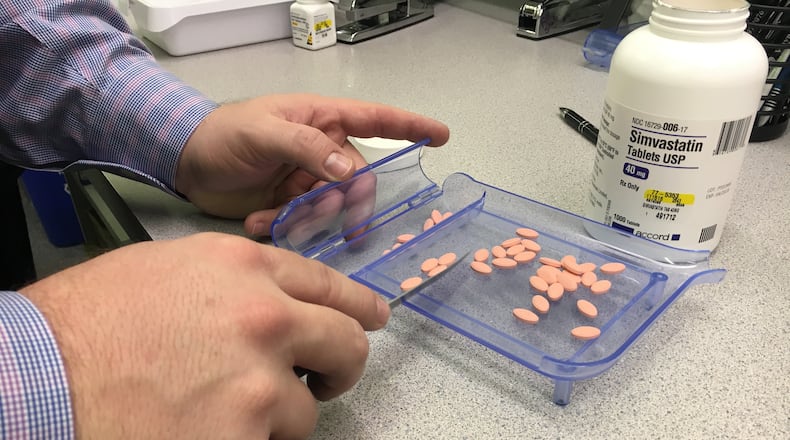However, some more information about how these pharmacy middlemen do business will be coming out soon.
Catching up? Read our latest pharmacy reporting here:
• Pharmacy middlemen made $223.7M from Ohio Medicaid
• With small pharmacies disappearing, Medicaid cuts seen as culprit
• DeWine anticipates ‘major litigation’ against pharmacy middlemen
While the full details of an Ohio Medicaid report on pharmacy benefit managers remains blocked by a court injunction, a Franklin County judge on Wednesday afternoon ordered that any parts of the report that are not in dispute should be released.
The information that both sides agree is not trade secrets could be made public as soon as Friday . There will be a preliminary hearing Sept. 17 on the parts of the report that CVS and Optum are seeking to block and Ohio Medicaid wants to release.
“Transparency is not only the duty of government to its owners, the people of Ohio, but its also essential for the market to function properly,” said Tom Betti, spokesman for Ohio Medicaid. “And we believe this deeply and we will continue to pursue it. Our position has not changed.”
A summary of the report was released by Ohio Medicaid in June and showed CVS Caremark kept 8.7 percent or the payments it received, or $197.3 million. OptumRx does work for the other insurer and kept 9.4 percent, or $26.4 million. The full report contains additional details.
CVS Health, the original plaintiff in the case, said in a statement that the company is pleased with the judge’s decision, and that the company balances both the need to protect business-critical information with the public’s right for transparency into how their tax dollars are being spent.
“Making public information such as the proprietary rates, formulas and our negotiation strategy to achieve lower drug prices and cost-effective dispensing within our pharmacy network would significantly impact our ability to negotiate the lowest rates and fees in a highly competitive market, which would ultimately cost the state and the taxpayers more,” CVS stated.
MORE: Moving to San Diego could cost Teradata nearly $50 million
Separately, Ohio Auditor Dave Yost has been examining pharmacy benefit managers and plans to make his office’s findings public on Aug. 16. Yost will present the report that day to the panel of lawmakers that oversee Medicaid, the Joint Medicaid Oversight Committee.
The auditor’s analysis will cover similar ground to the Ohio Medicaid report but will also break down differences in how much pharmacy benefit managers kept by some drug types and whether there are differences in how much the companies kept from geographical region to region around the state.
The report will also look into whether there’s a correlation between pharmacies closing down and the amount of money for pharmaceuticals that the pharmacy middlemen kept.
The auditor’s report and the full Ohio Medicaid report could help shed light on the cloudy pharmaceutical supply chain, where drug makers, distributors, pharmacy benefit managers, providers and insurers all point the finger at each other in the debate over skyrocketing prices.
States have been spending larger and larger portions of their budgets on Medicaid, which is jointly funded with federal dollars. A key driver of those rising costs are prescription drugs. This not only squeezes the low-income health insurance program but also puts pressure on other state programs that are all vying for a limited amount of tax dollars.
When Ohio Medicaid handed management of Medicaid plans to private companies — and those companies handed management of pharmacy benefits to other private companies — the state was able to keep costs contained and predictable.
Medicaid saved $145 million under the privatized system compared to the former system where the Ohio directly paid fees for services, according to the state. CVS has continued to highlight the savings, saying it shows their services “benefit the state of Ohio and Ohio taxpayers by effectively managing Medicaid expenditures.”
MORE: Employed but uninsured? In Ohio, you’re not alone
But while the system controls costs, some critics have said that has been at the expense of transparency and market competition.
Lawmakers and pharmacists have called into question whether the pharmacy middlemen are keeping too much of the state money and paying pharmacists too little, causing some pharmacies to go out of business or sell their businesses.
“In my experience, transparent marketplaces tend to be leaner,” Antonio Ciaccia, with the Ohio Pharmacists Association. The association, which lobbies on behalf of pharmacists, has pushed for more transparency on how pharmacy benefit mangers do business and argued the pharmacy middlemen pay pharmacies too little.
Some pharmacies have sold to CVS, which not only owns a chain of retail pharmacies but also owns a pharmacy benefit management division that acts as a pharmacy middleman for four out of five of the companies privately managing Ohio Medicaid plans.
About the Author
